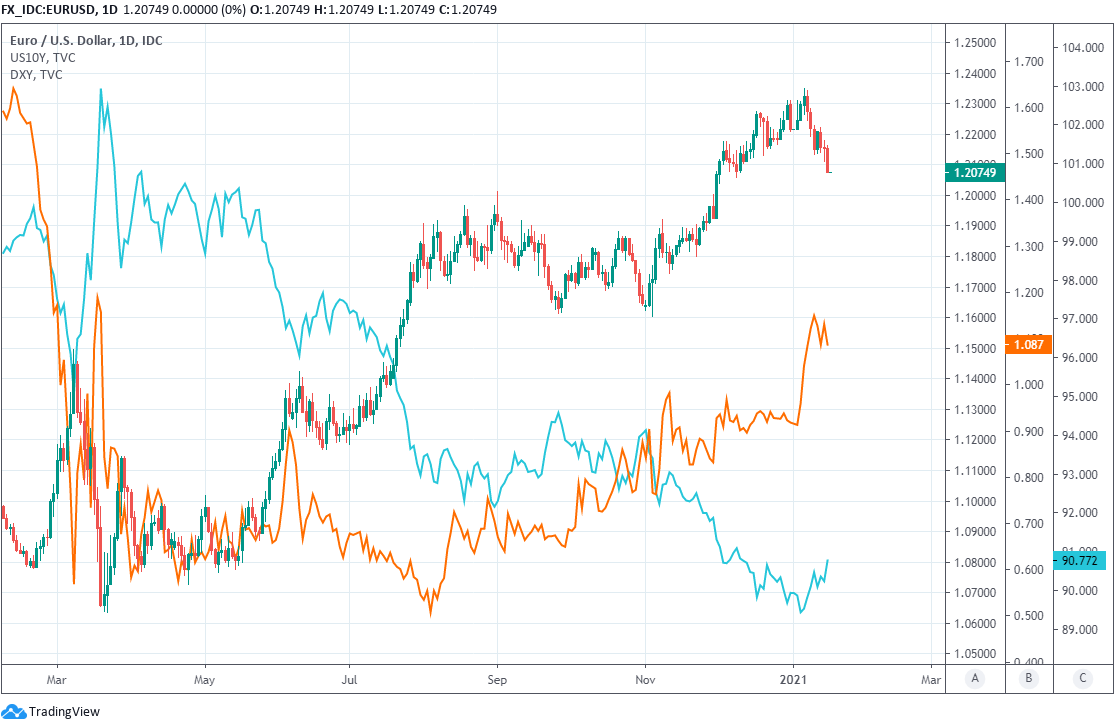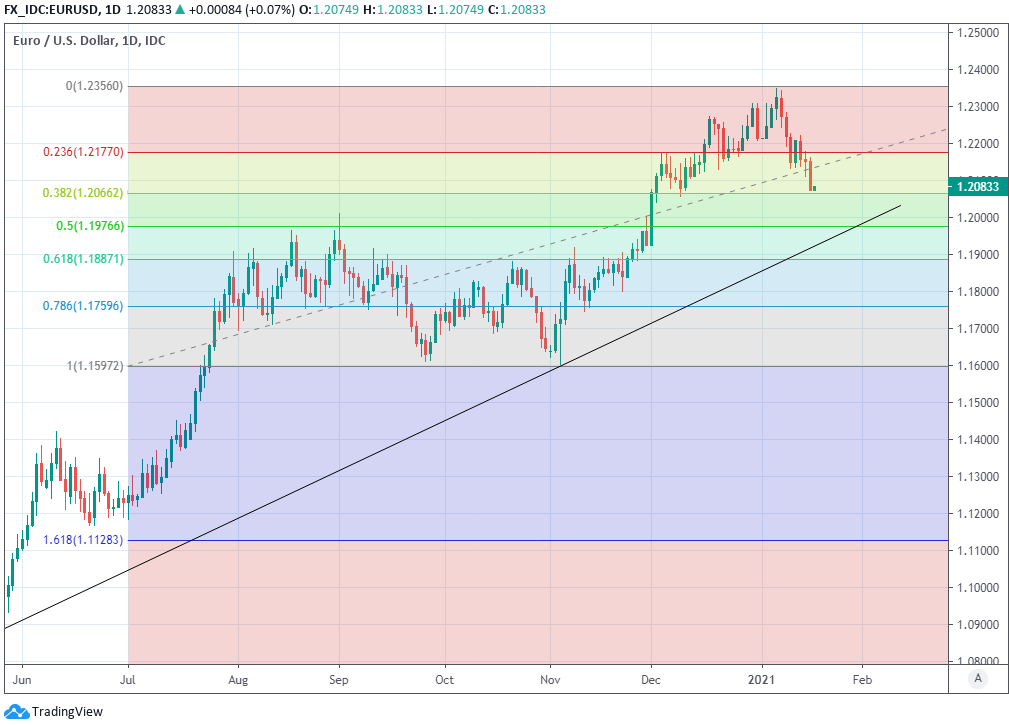Euro-Dollar Week Ahead Forecast: Six Week Low In Sight as Rally Falters and ECB Looms
- Written by: Gary Howes
- EUR/USD correction set to continue as analysts tip fall to 1.20.
- ECB rhetoric elevated risk to EUR after TWI reaches new highs.
- AS vaccine delays sour sentiment and U.S. inauguration looms.
- EUR has historical tendency to weaken after U.S. inaugurations.

Image © European Union - European Parliament, Reproduced Under CC Licensing.
- EUR/USD spot rate at time of writing: 1.2078
- Bank transfer rate (indicative guide): 1.1657-1.1742
- FX specialist providers (indicative guide): 1.1899-1.1995
- More information on FX specialist rates here
The Euro-to-Dollar exchange rate starts the new week softer and further declines are possible over the coming days as European Central Bank (ECB) currency concerns, a setback on vaccinations and bearish technical signals from charts all point the single currency toward six-week lows around 1.20.
The Euro fell more than one percent against the Dollar last week as rising U.S. bond yields lifted the greenback, while investor risk-aversion weighed broadly on assets like stocks, commodities and positively correlated currencies over the course of Friday.
A collapsing Italian government that threatens to bring about new elections was also widely cited for weakness, while an extended 'lockdown' in Germany and reports suggesting that Pfizer has delayed deliveries of its vaccine due to manufacturing problems at a site in Belgium may also have contributed to underperformance.
These factors will be joined by European Central Bank (ECB) rhetoric on currency strength and the Euro's tendency to weaken around U.S. Presidential inaugurations in holding back or otherwise inspiring further losses this week.
However, technical analysts are also flagging the charts as a continued source of downside risk too.
Five analysts provide insight and justification below for why they now see the Euro-to-Dollar exchange rate slipping back to 1.20 over the coming days and what would be a six-week low although, and fortunately for the single currency, all anticipate that this is simply a corrective setback within a broader uptrend that should soon resume.
"Euro divergences from RSI and MACD warned of a correction, the channel line has since broken and a decline is underway. We see Fibonacci retracements of 1.2064, 1.1976 and 1.1888 to be aware of. We are uncertain if spot breaks below 1.20," says Paul Ciana, CMT and chief technical strategist at BofA Global Research, who's colleagues forecast a year-end Euro-Dollar rate of 1.25. "We think the dip in euro is tied to the overbought oil rally and the oversold bond market."

Source: BofA Global Research.
Previously the Euro had risen to its highest since April 2018 when trading at 1.2350 during early January in moves that lifted the trade-weighted currency above its September 2020 peak and also over the top seen in the 2017 EUR/USD rally. This is unlikely to be welcomed by the ECB, which will have a chance to remark on the Euro on Thursday when its latest policy decision is released at 12:45 and President Christine Lagarde leads a press conference at 13:30.
"Little is expected of the ECB after December’s easing measures. However, we would expect President Lagarde to say that the ECB is ‘monitoring the exchange rate carefully’, wary of the euro’s impact on an already subdued inflation rate," says Petr Krpata, chief EMEA strategist for currencies and interest rates at ING. "Wrapping up, ongoing Italian political uncertainty and a steadier dollar could briefly see EUR/$ trade 1.1980."
{wbamp-hide start} {wbamp-hide end}{wbamp-show start}{wbamp-show end}
There's little the ECB could actually do to keep the Euro down but with other central banks now intervening directly to limit their currency's appreciation, the risk of harsher rhetoric or some form of action may have grown. Thursday's ECB appointment could ensure a lacklustre performance from the Euro early this week, or simply that any corrective gains accrued over the early days are susceptible to being unwound ahead of the event. But the U.S. presidential inauguration is also a threat to the Euro.
"More often than not (9 out of 12 times), EUR/USD drops in the aftermath of a presidential inauguration," says Martin Enlund, chief FX strategist at Nordea Markets. "We are less gullible buyers of risk for now, but would consider using levels around 1.1950 in EUR/USD to go long again."

Above: EUR/USD at daily intervals with 10-year U.S. government bond yield (orange) and U.S. Dollar Index (blue).
Biden's speech at the ceremony will be listened to closely for clues on how soon he expects to make vaccinations available to all of the U.S. population and how else he might support the economy in the interim. It comes amid investor worries about whether a proposed $1.9 trillion aid package will make it through Congress, although financial support for the U.S. economy was already larger than in Europe and is now an additional Euro-negative risk to the transatlantic growth outlook.
"The USD and GBP have benefitted recently from the scaling back of Fed and BoE easing expectations in light of building speculation over larger US fiscal stimulus and the UK economy holding up better than expected during lockdown 2 which reduces pressure on the BoE to ease again as soon in February," says Derek Halpenny, head of research, global markets EMEA and international securities at MUFG. "There is room for EUR weakness to extend further in the near-term but we do not expect a much deeper correction. EUR/USD is then expected to begin consolidating at higher levels between 1.2000 and 1.2500."
Secure a retail exchange rate that is between 3-5% stronger than offered by leading banks, learn more.
Meanwhile, the Eurozone was dealt another blow last week by reports suggesting deliveries of Pfizer vaccines could be delayed when Europe was already facing a longer timeline with lesser deliveries over a more prolonged period than the UK after being slow to negotiate to agreements with pharmaceutical companies. Delays potentially enhance European economic risks and for this reason could heighten the Euro's sensitivity to Friday's IHS Markit PMI surveys, which will estimate the damage done to services sectors across the continent by stricter 'lockdown' measures announced earlier this month. The data are due out between 08:15 and 10:00 on Friday.
"EUR/USD remains under pressure near term and has eroded 1.2130, the 21st December low. We look for losses to extend to 1.2014 the September high and even the 1.1922 2020-2021 uptrend, which we look to hold," says Karen Jones, head of technical analysis for currencies, commodities and bonds at Commerzbank. "Intraday rallies should struggle around 1.2220. Assuming that the uptrend (1.1922) holds; medium-term the market continues to track higher whilst targeting the 1.2556 2018 high and 1.2624, the 200 month moving average, which remains our longer term target."

Above: EUR/USD with Fibonacci retracements of Nov 2020 extension higher and 2020-2021 trendline (black) ,




